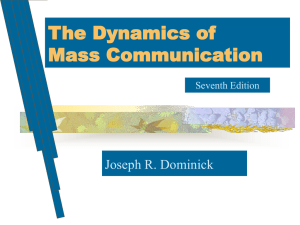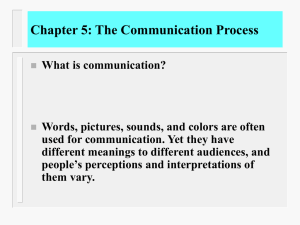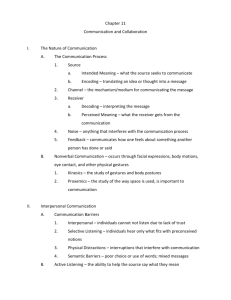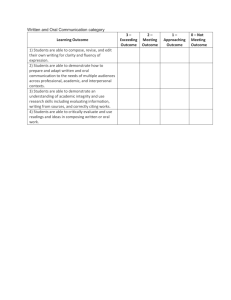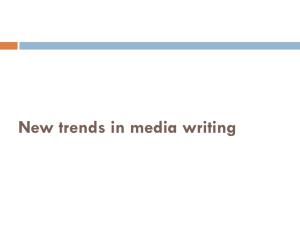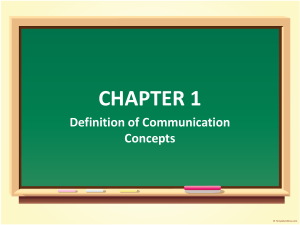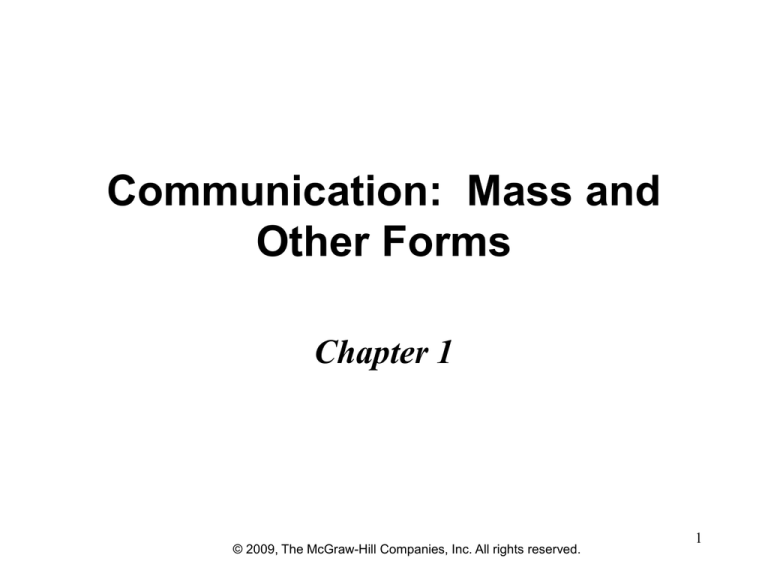
Communication: Mass and
Other Forms
Chapter 1
© 2009, The McGraw-Hill Companies, Inc. All rights reserved.
1
CHAPTER OUTLINE
•
•
•
•
•
The Communication Process
Communication Settings
Traditional Media Organizations
The Internet And Mass Communication
Models For Studying Mass
Communication
• Modern Mass Media: Emerging Trends
2
THE COMMUNICATION
PROCESS
Figure 1-1: Elements of the Communication Process
3
Transmitting the Message
•
•
•
•
Source
Encoding
Message
Channels
4
Receiving the Message
•
•
•
•
Decoding
Receiver
Feedback
Noise
5
COMMUNICATION
SETTINGS
• We will consider three different
communication settings
6
Interpersonal Communication
•
•
•
•
•
•
•
•
•
Individual or groups
Physical presence required
Encoding is a one-step process
Variety of channels
Messages hard for receiver to terminate
Little or no expense
Messages generally private
Messages can pinpoint specific targets
Immediate feedback
7
Machine-Assisted
Interpersonal Communication
(1 of 3)
SOURCE
-- machine -
RECEIVER
8
Machine-Assisted
Interpersonal Communication
(2 of 3)
• Source and receiver
– May be individuals or groups; may be machine
• Feedback
– Immediate or delayed; may be impossible
• Messages
– Customizability varies
– Private or public
– Inexpensive to send
9
Machine-Assisted
Interpersonal Communication
(3 of 3)
• Encoding can be simple to complex
– Source: thoughts words or symbols
– Machines: encode messages for transmission
• Channel options restricted
• Decoding similar to encoding
– Machines: electrical energy light patterns
– Receiver: words or symbols thoughts
10
Mass Communication
(1 of 3)
• Occurs when a complex organization,
with machine aid, produces and
transmits public messages to large,
heterogeneous, scattered audiences.
11
Mass Communication
(2 of 3)
• Pre-Internet: Source is structured
organization
• Internet: Source can be one person
• Sender gets little audience information
• Encoding is a multi-stage process
• Messages are public and impersonal
• Effective feedback difficult
12
Mass Communication
(3 of 3)
• Mass Communication Audiences
– Large
– Heterogeneous
– Geographically dispersed
– Individually anonymous
– Self-selected
13
Defining Mass Media
• Medium is channel through which message
travels from source to receiver
– “Medium” is singular; “Media” is plural
• Mass media are channels for mass
communication, and the institutions that
transmit the messages
• Media vehicle: single component of mass
media; newspaper, radio station, magazine
14
TRADITIONAL MEDIA
ORGANIZATIONS
• Traditional mass communicators share
some common characteristics
15
Formal Organizational
Structure
• Mass media typically have well-defined
organizational structure.
• Generally involves specialization and
division of labor.
• Generally a bureaucracy
• Channels of communication with
organization are generally formal.
16
Many Gatekeepers
• Gatekeeper: Any person/group
controlling what material eventually
reaches the public.
• More complex organizations = more
gatekeepers.
17
Large Operating Expenses
• Costs millions of dollars to buy and
maintain a mass media organization.
• Current trend: consolidation of media
ownership.
– Time Warner, Walt Disney Company, Sony,
News Corporation, Vivendi, Comcast,
Bertelsmann
18
Competition for Profits
• Most media organizations in US exist to
make a profit.
• Profit usually made by selling audiences
to advertisers
• Media organizations compete to attract
audiences
19
THE INTERNET AND MASS
COMMUNICATION
• Websites:
– Affordable, can be produced by individual
– Bypass gatekeepers
– Creativity reigns
– Low start-up and maintenance costs
– Audience competition not always a factor
20
MODELS FOR STUDYING
MASS COMMUNICATION
• The traditional model of mass
communication was a “one-to-many”
model. Media organizations encoded
information from the environment, and
reproduced it many times over using the
appropriate channel.
– Little direct interaction between sources
and receivers
21
An Internet Model of Mass Communication
(1 of 2)
Figure 1-3
22
An Internet Model of Mass
Communication
(2 of 2)
• A new arrangement, allowing multiple levels
of communication
–
–
–
–
–
One to one (email)
One to many (CNN.com)
Few to few (chatrooms, blogs)
Many to many (eBay)
Audience competition not always a factor
• Messages not linear; content provided by
organizations and users.
23
MODERN MASS MEDIA:
EMERGING TRENDS
• As media continue to evolve, several
trends have become apparent
24
Audience Segmentation: The
End of Mass Communication
as We Know it?
• Mass communication: Less mass, more
selective.
– Audience fractionalization or segmentation
– Reduced audience for any single media vehicle
– Definition of mass communication still applies;
audiences still large, organizations still complex
– Specialization is evident, but potential to reach
mass audience still exists
25
Convergence
• Convergence means coming together or
uniting in common theme or focus.
– Corporate Convergence. Companies acquire
assets extending range of activities.
– Operational Convergence. Owners of several
media properties combine operations.
– Device Convergence. One mechanism contains
functions of two or more devices.
26
Increased Audience Control
• Audience members can control what they see
and hear, and when.
• Technological advances (VCR, DVR, VOD)
give more power to consumer.
• More sources of information, including blogs
• More flexibility in consuming products
(download single track vs. buy full album)
27
Multiple Platforms
• A strategy making content available via a
number of different delivery methods to a
number of different receiving devices.
– Example: Music videos started on cable/satellite
networks, went to websites, to iPods, to cell
phones.
– Television content, newspaper content, magazine
content, all are repackaged for multiple devices.
28
User-Generated Content
• User-generated content (peer
production): people share and
collaborate on content.
– YouTube, MySpace, Flickr, Wikipedia
• Reflects Web 2.0
– Web 2.0 = communities, people, uploading
– Web 1.0 = companies, pages, downloading
29
Mobile Media
• Small screen devices allow media to
become increasingly mobile
– PDAs
– Cell phones
– Laptop computers
– iPods
• Significant milestone in development of
communication
30

